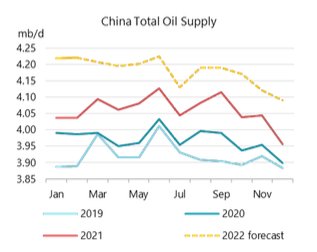Prevention is better than cure! Beijing will reduce its dependence on the West, as evidenced by the approach of CNOOC, the Chinese oil and gas giant, which will sell all its interests in Britain, Canada and the United States, reveals to Reuters. Threatened with sanctions for its support of Russia, itself subject to a Western embargo since the military invasion of Ukraine, Beijing wants to prevent some of its assets from being confiscated abroad.
China has not only refused to condemn the Russian operation, but plans to maintain good relations with Russia, whose hydrocarbons and other raw materials are interested in securing its supplies.
With the acquisition of Canadian producer Nexen in 2012 for $15.1 billion, CNOOC, which has state-owned company status, has grown into one of the largest producers of hydrocarbons in the world.
220,000 barrels of oil equivalent per day
The assets of the ex-Nexen – the name disappeared in 2019 to be integrated into the CNOOC brand – include interests in offshore fields in the North Sea, in the shale gas of northeastern British Columbia, in the exploration of offshore shale hydrocarbons. from Newfoundland and Labrador or at the Soderglen Wind Farm in southern Alberta, Canada. In the United States, CNOOC has assets in the onshore Eagle Ford and Rockies shale basins, as well as interests in two major offshore fields in the Gulf of Mexico, Appomattox and Stampede. Cumulative production, according to Reuters calculations, is about 220,000 barrels of oil equivalent per day (boed). Outside of China, CNOOC is present in about twenty countries.
In March, Reuters had indicated that the Chinese giant had given Bank of America a mandate to prepare for the sale of its North Sea assets, including a stake in one of the largest fields in the river basin.
Last October, the withdrawal from the New York Stock Exchange was completed. CNOOC was one of the Chinese companies that the Trump administration targeted it in 2020 because they were controlled by the Chinese military. It should be listed on the Shanghai Stock Exchange this month so it can continue to fund itself.
However, CNOOC does not shy away from developing internationally. The Chinese major will seek to acquire new assets in Latin America and Africa, and prioritize the development of new offshore projects in Brazil (where it is collaborating with Petrobras and Shell), in Guyana (with Exxon and Hess) and in Uganda and Tanzania (with TotalEnergies), according to the sources cited by Reuters.
A new configuration of globalization
CNOOC is one of the five largest oil companies in the country, with CNPC† Sinope† Yang Chang Petroleum and Sinochem Groupwith assets abroad.
The rivalry with the United States, which has taken on a new dimension with Western sanctions against Russia, could lead to a new configuration of globalization diplomatic Which commercial break† This prospect prompts China to secure its vital supplies for its economic development.
The country is consuming more and more oil. After 13.1 million barrels per day (mbd) in 2021, it should burn 15.7 mbd in 2022 (+9.1%), according to the latest monthly report from the International Energy Agency (IEA). And even if it has increased its local production (see chart), it remains largely insufficient to meet needs, especially for petroleum products.
†

†
This is one of the reasons that will push China, as well as India and other Asian countries, to develop purchases of Russian oil, especially as they are sold at a discount†
Urgency to find an outlet for Russia
There is no sign of such a significant movement for the time being, the IEA notes in the data for February and March. “It remains to be seen whether Asian buyers will be able to absorb Russian crude oil and petroleum products that used to be bought by Europe and which are banned in the US, UK, Canada and Australia. Without a full redistribution, Russia may have to stop further oil production with possible longer-term consequences for global supply”explains the IEA, which expects a decline of 1.5 mb/d in April and then almost 3 mb/d in May in Russian production.
The urgency to find an outlet for its hydrocarbon imports is primarily imposed more on Russia than on its Asian customers. China, which is under pressure from Washingtonlearns the first lessons of the Ukrainian conflict and begins to prepare, just in case.




